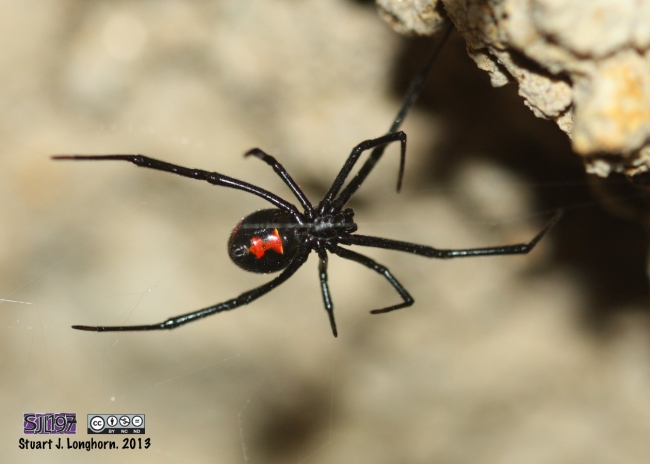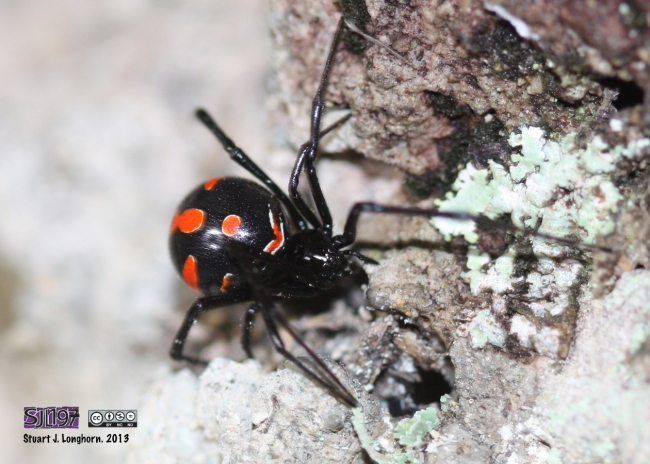It has been reproduced here with the kind permission of Christie Louise Tucker
So like a bothersome pest – completely unlike our subject, which sits in a web and bothers no-one – the horror stories about deadly spiders just will not go away. Since the publication of my well-received first article, the gutter press have continued to spout their hysterical headlines: everything from vulnerable single mothers being attacked by spiders to babies eating False Widows, before resorting to writing about a mother just seeing and killing spiders – even though none of those spiders that she had killed was Steatoda nobilis. Bravo!
It’s all getting a little silly and thankfully, due to the efforts of myself and many likeminded individuals, the message seems to be getting though. Increasingly, the articles are being lambasted by the general citizenry for what they are: scurrilous attempts at scaremongering. So, while I’m pleased that people are now a little more informed about Steatoda nobilis I feel it would be remiss of us if I didn’t try to impart the same level of education on the part of Latrodectus mactans, the Black Widow spider, the new target of the tabloids’ sensationalist hyperbole with headlines like “Black Widow spider invasion from US sparks fear of lethal bites.
So we’d like to introduce you to the real Black Widow, and hopefully by the end of this article we can turn the much-feared Black Widow into the much respected Black Widow instead.
What’s in a name?
The Black Widow’s very moniker is designed to spread fear, coined for the female’s penchant for killing and eating the male spider shortly after mating. Far from being the Black Widow’s particular party trick, the males’ fate in the spider kingdom is frequently -although not always- to be eaten by the female. From a logical perspective this can make sense and is not simply a cruel act by Mrs Spider. Male spiders usually die shortly after reaching maturity. Their biological purpose is to become mature and mate. Once this has been achieved the male is redundant. He has passed on his genetic code and his existence is no longer biologically imperative. Please note, however, that the male does not willingly offer himself up: he has a sense of self-preservation and will likely try to escape after performing the deed. They just don’t always make it.From the female’s perspective, she is about to lay hundreds of eggs which she will wrap up in a silken sac and defend with her life. Therefore, it is sensible to absorb as much nutrition as possible, and a male spider makes a fine meal. The male is sacrificed as a cruel necessity. So technically, all spiders have the potential to be ‘widows’ and there’s no real reason for Latrodectus to claim sole rights to the name. But then I guess just calling it the clumsy black-and-red spider doesn’t really have the same ring to it, eh? For the record, the Genus name Latrodectus comes from the Greek for ‘biting in secret’- they don’t just name these spiders at random, you know!
Taken by Stuart Longhorn, Latrodectus Sp. in natural habitat in Central America
The lady herself
Just like Steatoda, the False Widows –including the species S.nobilis, the Noble False Widow of recent reports – it is the females of Latrodectus that bite. The females are easy to distinguish being many times larger and bulkier than the males. The Eastern Black Widow Spider (Latrodectus mactans) is one of 32 confirmed species, and is usually jet black, (although some variations with dorsal red markings exist) with a highly distinctive red hourglass marking on the underneath of the abdomen of both sexes, although it is more vivid on a female. Certainly experts should not be troubled with the same volume of mistaken Identity cases that Steatoda has caused, resembling as it does so many other UK species currently being slaughtered in its stead. This said there is significant variety amongst Latrodectus with many weird and wonderful variants each more colourful than the last.Despite the papers’ reports about the abundance and deadliness of Black Widows in the UK, they are found here in very small numbers. They came over in imports from the US, this much is true, but they are isolated to just a few small colonies in the south in and are not likely to be seen. The main reason for this is that they like to stay in their webs and are not likely to attack. In fact, Latrodectus are comically uncoordinated when not in their haphazard webs and could quite comfortably be described as clumsy; certainly more Bridget Jones than Femme Fatale. Subsequently, you are very unlikely to see one or even be close to one, and given their distinctive markings and lack of similarity to other species it is likely that reports will be few and far between. They are also rather small, reaching no more than 4cm or so. So in a nutshell, you’re looking for small black spiders that have a distinctive, easily-seen hourglass shape on the ‘belly’, and stay in a haphazard-looking web. Most of us will go our entire lives without ever seeing one.
The reports
We’ll take an article from the stalwart of shoddy reporting, the Daily Star, who have featured a spider story every day this week and show no signs of stopping: Black Widow spider invasion from US sparks fear of lethal bites. This article should be issued to GCSE Media Studies classes for careful language analysis. First, this must be the first time ‘six’ has constituted an invasion. Secondly, all of Graeme Skinner’s quotes have been taken out of context. The line “Black Widows have come in this year” is a statement, not a warning: they come in every year, along with many other species that don’t get reported or become an established species. “Experts fear there could be widespread deaths,” but mysteriously wouldn’t go on the record to comment further on that? Thirdly, the only thing “terrifying Brits” is the tabloids’ misjudged reports.Ricki Whitmore may have suffered a gruesome leg wound, but it was almost certainly not from the venom or the bite; secondary infection is the most likely cause. Also, “it is only a matter of time before they kill” is a dangerously misleading overstatement, and is directly contradicted in Mr Skinner’ next quote. For the record, nearly anyone can get a Dangerous Wild Animals License, provided certain criteria are met and the license fee (which varies hugely from borough to borough) is paid. We at the Elwell Press feel that the spider’s bite is the least of the Star editorial team’s worries – ifLatrodectus could engage a libel lawyer, the arachnophobes of Wapping would really be in trouble.
The bite
If you are ever unfortunate enough to be bitten by a Latrodectus species, then seek medical attention immediately, retaining the spider’s body in a secure container for examination if possible. Although unlikely to be fatal to a healthy adult, being bitten will be a deeply unpleasant experience. Typical symptoms are localised swelling, nausea, tremors, a fever, and painful muscle cramping. Like Steatoda,Latrodectus has a neurotoxic venom, although it will certainly not rot or dissolve your flesh. Latrodectusbites have killed in the past, although fatalities are extremely rare. The young or the old are particularly vulnerable as their bodies lack the capacity to safely metabolize the venom. However, an effective anti-venom against toxic components of Latrodectusvenom has existed for many years, and been regularly used throughout the world for effective treatment of bites.As worrying as that sounds, there is another glimmer of good news. As stated previously, you are extremely unlikely to ever encounter a Black Widow spider. The chances of coming across one are infinitesimally small; in spite of recent claims, they exist in tiny numbers in the UK and, like all spiders, will avoid human interaction as far as possible. This round of fearmongering will backfire on the papers as the lack of sightings fail to hold readers’ interest. This correspondent has been asked to identify a great many spiders in photographs of varying quality, some of which were barely recognisable as spiders. None of these have been Latrodectus, and only about 20 percent have even been Steatoda. It would be astonishing should widespread reports of Black Widow spiders surface.
In time, Latrodectus may well become an established species in the UK. As climate change continues to be a powerful force in dictating animal habitat and behaviour, we may well see, in several years’ time, Black Widow spiders becoming more prevalent. In that eventuality, what will we do? Well, I guess we’ll just have to deal with it the same way that other countries where these spiders are abundant do: with caution but not panic, with respect but not fear. Leave well enough alone and no harm will come to you. Deaths from Latrodectus venom are extremely uncommon, normally only occurring in freak instances where multiple bites are recorded.
In the UK, we do not have overtly dangerous or lethal species present in the wild in any great numbers. From an exotic animal perspective, we are a rather boring island. Should we ever reach the stage where such potentially harmful invertebrates are more commonplace, then we will simply need to adapt. After all, if Latrodectus ever became that much of a problem an antivenom is readily available; that there is no antivenom for Steatoda bites should indicate the seriousness with which their bites are to be regarded. So let’s not lose our heads when we have extremely isolated and small numbers of a relatively medically significant spider like Latrodectus present as an interloper from foreign shores. Stiff upper lip and all, chaps! Best foot forward, and in true British fashion, let’s keep calm and carry on.


No comments:
Post a Comment